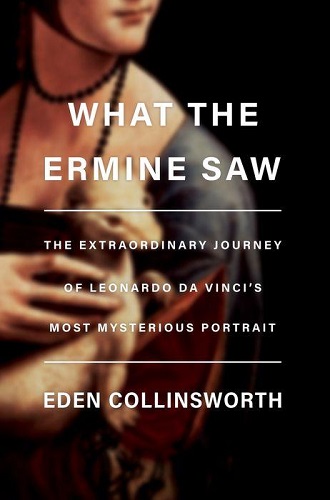
WHAT THE ERMINE SAW
by Eden Collinsworth
The remarkable true story behind one of history’s most enigmatic portraits—”a glorious picaresque of unbridled passions and unmitigated scoundrels, a glorious romp through the great palaces and palazzos of Europe” (Amanda Foreman, New York Times best-selling author of Georgiana, Duchess of Devonshire)
Five hundred and thirty years ago, a young woman sat before a Grecian-nosed artist known as Leonardo da Vinci. Her name was Cecilia Gallerani, and she was the young mistress of Ludovico Sforza, duke of Milan. Sforza was a brutal and clever man who was mindful that Leonardo’s genius would not only capture Cecilia’s beguiling beauty but also reflect the grandeur of his title. But when the portrait was finished, Leonardo’s brush strokes had conveyed something deeper by revealing the essence of Cecilia’s soul. Even today, The Woman with an Ermine manages to astonish.
Despite the work’s importance in its own time, no records of it have been found for the two hundred and fifty years that followed Gallerani’s death. Readers of The Hare with the Amber Eyes will marvel at Eden Collinsworth’s dexterous story of illuminates the eventual history of this unique masterpiece, as it journeyed from one owner to the next–from the portrait’s next recorded owner, a Polish noblewoman, who counted Benjamin Franklin as an admirer, to its exile in Paris during the Polish Soviet War, to its return to WWII-era Poland where—in advance of Germany’s invasion—it remained hidden behind a bricked-up wall by a housekeeper who defied Hitler’s edict that it be confiscated as one of the Reich’s treasures. Fans of Anne-Marie O’Connor’s The Lady in Gold will treasure the story of this criss-crossing journey and the enigmatic woman at its heart.
What the Ermine Saw is a fact-based story that cheats fiction and a reminder that genius, power, and beauty always have a price.

TO RISK IT ALL
by Adm. James Stavridis
From one of the great naval leaders of our time, a master class in decision-making under pressure through the stories of nine famous acts of leadership in battle, drawn from the history of the United States Navy, with outcomes both glorious and notorious
At the heart of Admiral James Stavridis’s training as a naval officer was the preparation to lead sailors in combat, to face the decisive moment in battle whenever it might arise. In To Risk it All, he offers up nine of the most useful and enthralling stories from the US Navy’s nearly 250-year history, and draws from them a set of insights that we can all put to use when confronted with fateful choices.
Conflict. Crisis. Risk. These words have a distinct meaning in a military context that we hope will never apply identically in our own lives. But at the same time, as Admiral Stavridis shows with great clarity, many lessons are universal.
To Risk it All is filled with thrilling and heroic exploits, but it is anything but a shallow exercise in myth burnishing. Every leader in this book has real flaws, as all humans do, and the stories of failure, or at least the decisions that have been defined as such, are as crucial as the stories of success. In the end, when this master class is concluded, we will be better armed for hard decisions both expected and not.
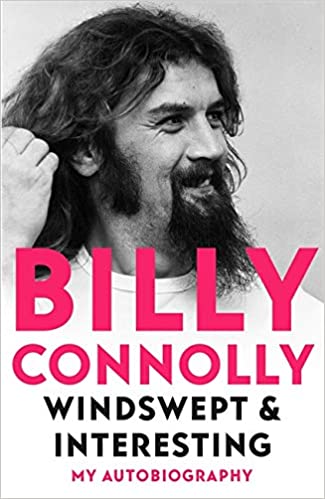
WINDSWEPT & INTERESTING
by Billy Connolly
In his first full-length autobiography, comedy legend and national treasure Billy Connolly reveals the truth behind his windswept and interesting life.
Born in a tenement flat in Glasgow in 1942, orphaned by the age of 4, and a survivor of appalling abuse at the hands of his own family, Billy’s life is a remarkable story of success against all the odds.
Billy found his escape first as an apprentice welder in the shipyards of the River Clyde. Later he became a folk musician – a ‘rambling man’ – with a genuine talent for playing the banjo. But it was his ability to spin stories, tell jokes and hold an audience in the palm of his hand that truly set him apart.
As a young comedian Billy broke all the rules. He was fearless and outspoken – willing to call out hypocrisy wherever he saw it. But his stand-up was full of warmth, humility and silliness too. His startling, hairy ‘glam-rock’ stage appearance – wearing leotards, scissor suits and banana boots – only added to his appeal.
It was an appearance on Michael Parkinson’s chat show in 1975 – and one outrageous story in particular – that catapulted Billy from cult hero to national star. TV shows, documentaries, international fame and award-winning Hollywood movies followed. Billy’s pitch-perfect stand-up comedy kept coming too – for over 50 years, in fact – until a double diagnosis of cancer and Parkinson’s Disease brought his remarkable live performances to an end. Since then he has continued making TV shows, creating extraordinary drawings… and writing.
Windswept and Interesting is Billy’s story in his own words. It is joyfully funny – stuffed full of hard-earned wisdom as well as countless digressions on fishing, farting and the joys of dancing naked. It is an unforgettable, life-affirming story of a true comedy legend.
‘I didn’t know I was Windswept and Interesting until somebody told me. It was a friend who was startlingly exotic himself. He’d just come back from Kashmir and was all billowy shirt and Indian beads. I had long hair and a beard and was swishing around in electric blue flairs.
He said: “Look at you – all windswept and interesting!”
I just said: “Exactly!”
After that, I simply had to maintain my reputation…’
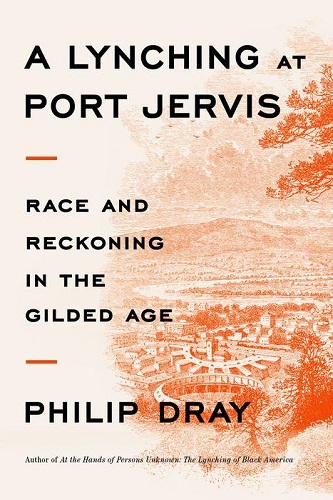
A LYNCHING AT PORT JERVIS
by Philip Dray
An account of a lynching that took place in New York in 1892, forcing the North to reckon with its own racism.
On June 2, 1892, in the small, idyllic village of Port Jervis, New York, a young Black man named Robert Lewis was lynched by a violent mob. The twenty-eight-year-old victim had been accused of sexually assaulting Lena McMahon, the daughter of one of the town’s well-liked Irish American families. The incident was infamous at once, for it was seen as a portent that lynching, a Southern scourge, surging uncontrollably below the Mason-Dixon Line, was about to extend its tendrils northward. What factors prompted such a spasm of racial violence in a relatively prosperous, industrious upstate New York town, attracting the scrutiny of the Black journalist Ida B. Wells, just then beginning her courageous anti-lynching crusade? What meaning did the country assign to it? And what did the incident portend?
Today, it’s a terrible truth that the assault on the lives of Black Americans is neither a regional nor a temporary feature, but a national crisis. There are regular reports of a Black person killed by police, and Jim Crow has found new purpose in describing the harsh conditions of life for the formerly incarcerated, as well as in large-scale efforts to make voting inaccessible to Black people and other minority citizens. The “mobocratic spirit” that drove the 2021 attack on the U.S. Capitol―a phrase Abraham Lincoln used as early as 1838 to describe vigilantism’s corrosive effect on America―frightfully insinuates that mob violence is a viable means of effecting political change. These issues remain as deserving of our concern now as they did a hundred and thirty years ago, when America turned its gaze to Port Jervis.
An alleged crime, a lynching, a misbegotten attempt at an official inquiry, and a past unresolved. In A Lynching at Port Jervis, the acclaimed historian Philip Dray revisits this time and place to consider its significance in our communal history and to show how justice cannot be achieved without an honest reckoning.
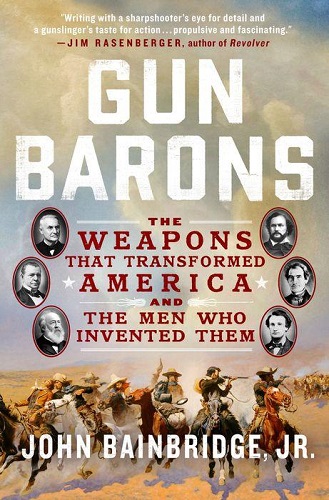
GUN BARONS
by John Bainbridge, Jr.
John Bainbridge, Jr.’s Gun Barons is a narrative history of six charismatic and idiosyncratic men who changed the course of American history through the invention and refinement of repeating weapons.
Love them or hate them, guns are woven deeply into the American soul. Names like Colt, Smith & Wesson, Winchester, and Remington are legendary. Yet few people are aware of the roles these men played at a crucial time in United States history, from westward expansion in the 1840s, through the Civil War, and into the dawn of the Gilded Age. Through personal drive and fueled by bloodshed, they helped propel the young country into the forefront of the world’s industrial powers.
Their creations helped save a nation divided, while planting seeds that would divide the country again a century later. Their inventions embodied an intoxicating thread of American individualism―part fiction, part reality―that remains the foundation of modern gun culture. They promoted guns not only for the soldier, but for the Everyman, and also made themselves wealthy beyond their most fevered dreams.
Gun Barons captures how their bold inventiveness dwelled in the psyche of an entire people, not just in the minds of men who made firearm fortunes. Whether we revere these larger-than-life men or vilify them, they helped forge the American character.

A BRIGHT AND BLINDING SUN
by Marcus Brotherton
From a New York Times bestselling author comes the incredible true story of an underage soldier’s first love and loss on the battlefields of Bataan and Corregidor—perfect for fans of The Boy Who Followed His Father into Auschwitz and Unbroken.
Joe Johnson Jr. ran away from home at the age of 12, hopping a freight train at the height of the Great Depression. He managed to talk his way into the U.S. Army two years later. Seeking freedom and adventure, he was sent to the Philippines.
Adrift in spirit, Joe visited a teenage prostitute, and they became unlikely, smitten allies. Yet when the Japanese attacked on December 8, 1941, their hopes of being together had to wait.
Joe and his fellow soldiers fought for four brutal months in Bataan and Corregidor, until they were forced to surrender. The boy endured years of horror as a prisoner of war, only dreaming about seeing again the girl he’d come to love.
This lyrically written and deeply encouraging saga will remind you that every life can be lifted, forgiveness is the patron of restoration, and redemption is available to all.

THE HANGMAN AND HIS WIFE
by Nancy Dougherty
An astonishing journey into the heart of Nazi evil: a portrait of one of the darkest figures of Hitler’s Nazi elite—Reinhard Heydrich, the designer and executor of the Holocaust, chief of the Reich Main Security, including the Gestapo—interwoven with commentary by his wife, Lina, from the author’s in-depth interviews.
He was called the Hangman of the Gestapo, the “butcher of Prague,” with a reputation as a ruthlessly efficient killer. He was the head of the SS, and the Gestapo, second in command to Heinrich Himmler. His orders set in motion the Kristallnacht pogrom of 1938 and, as the lead planner of Hitler’s Final Solution, he chaired the Wannsee Conference, at which details of the murder of millions of Jews across Nazi-occupied Europe were toasted with cognac.
In The Hangman and His Wife, Nancy Dougherty, and, following her death, Christopher Lehmann-Haupt, masterfully explore who Heydrich was and how he came to be, and how he came to do what he did. We see Heydrich from his rarefied musical family origins and his ugly-duckling childhood and adolescence, to his sudden flameout as a promising Naval officer (he was forced to resign his Naval commission after dishonoring the office corps by having sex with the unmarried daughter of a shipyard director and refusing to marry her).
Dougherty writes of his seemingly hopeless job prospects as an untrained civilian during Germany’s hyperinflation and unemployment, and his joining the Nazi party through the attraction to Nazism of his fiancée, Lina von Osten, and her father, along with the rumor shadowing him of a strain of Jewishness inherited from his father’s side. And we follow Heydrich’s meteoric rise through the Nazi high command—from SS major, to colonel to brigadier general, before he was thirty, deputy to Heinrich Himmler, expanding the SS, the Gestapo, and developing the Reich’s plans for “the Jewish solution.”
And throughout, we hear the voice of Lina Heydrich, who was by his side until his death at the age of thirty-eight, living inside the Nazi inner circles as she waltzed with Rudolf Hess, feuded with Hermann Göring, and drank vintage wine with Albert Speer.
Still Hot in Non-Fiction & Biography

I'LL SHOW MYSELF OUT
by Jessi Klein
An instant New York Times bestseller, I’ll Show Myself Out is the eagerly anticipated second essay collection from Jessi Klein, author of the acclaimed debut You’ll Grow Out of It.
“Sometimes I think about how much bad news there is to tell my kid, the endlessly long, looping CVS receipt scroll of truly terrible things that have happened, and I want to get under the bed and never come out. How do we tell them about all this? Can we just play Billy Joel’s We Didn’t Start the Fire and then brace for questions? The first of which should be, how is this a song that played on the radio?”
In New York Times bestselling author and Emmy Award-winning writer and producer Jessi Klein’s second collection, she hilariously explodes the cultural myths and impossible expectations around motherhood and explore the humiliations, poignancies, and possibilities of midlife.
In interconnected essays like “Listening to Beyoncé in the Parking Lot of Party City,” “Your Husband Will Remarry Five Minutes After You Die,” “Eulogy for My Feet,” and “An Open Love Letter to Nate Berkus and Jeremiah Brent,” Klein explores this stage of life in all its cruel ironies, joyous moments, and bittersweetness.
Written with Klein’s signature candor and humanity, I’ll Show Myself Out is an incisive, moving, and often uproarious collection.

HELLO, MOLLY!
by Molly Shannon
A New York Times bestseller
A candid, compulsively readable, hilarious, and heartbreaking memoir of resilience and redemption by comedic genius Molly Shannon
At age four, Molly Shannon’s world was shattered when she lost her mother, baby sister, and cousin in a car accident with her father at the wheel. Held together by her tender and complicated relationship with her grieving father, Molly was raised in a permissive household where her gift for improvising and role-playing blossomed alongside the fearlessness that would lead her to become a celebrated actress.
From there, Molly ventured into the wider world of New York and Los Angeles show business, where she created her own opportunities and developed her daring and empathetic comedy. Filled with behind-the-scenes stories involving everyone from Whitney Houston to Adam Sandler to Monica Lewinsky, many told for the first time here, Hello, Molly! spans Molly’s time on Saturday Night Live—where she starred alongside Will Ferrell, Adam Sandler, Cheri Oteri, Tracy Morgan, and Jimmy Fallon, among many others. At the same time, it explores with humor and candor her struggle to come to terms with the legacy of her father, a man who both fostered her gifts and drive and was left with the impossible task of raising his kids alone after the loss of her mother.
Witty, winning, and told with tremendous energy and heart, Hello, Molly!, written with Sean Wilsey, sheds new and revelatory light on the life and work of one of our most talented and free-spirited performers.
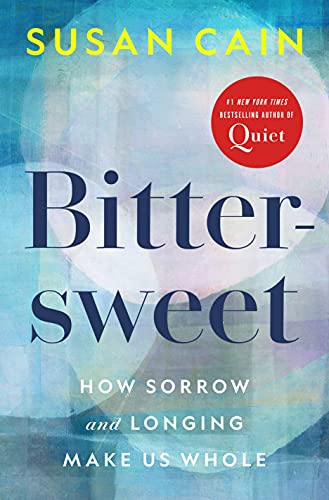
BITTERSWEET
by Susan Cain
#1 NEW YORK TIMES BESTSELLER • Sadness is a superpower. In her new masterpiece, the author of the bestselling phenomenon Quiet reveals the power of a bittersweet outlook on life, and why we’ve been so blind to its value.
“Bittersweet grabs you by the heart and doesn’t let go.”—BRENÉ BROWN, author of Atlas of the Heart
“Susan Cain has described and validated my existence once again!”—GLENNON DOYLE, author of Untamed
“A sparkling ode to the beauty of the human condition.”—ADAM GRANT, author of Think Again
ONE OF THE MOST ANTICIPATED BOOKS OF 2022—Oprah Daily, BookPage
Bittersweetness is a tendency to states of longing, poignancy, and sorrow; an acute awareness of passing time; and a curiously piercing joy at the beauty of the world. It recognizes that light and dark, birth and death—bitter and sweet—are forever paired.
If you’ve ever wondered why you like sad music . . .
If you find comfort or inspiration in a rainy day . . .
If you react intensely to music, art, nature, and beauty . . .
Then you probably identify with the bittersweet state of mind.
With Quiet, Susan Cain urged our society to cultivate space for the undervalued, indispensable introverts among us, thereby revealing an untapped power hidden in plain sight. Now she employs the same mix of research, storytelling, and memoir to explore why we experience sorrow and longing, and how embracing the bittersweetness at the heart of life is the true path to creativity, connection, and transcendence.
Cain shows how a bittersweet state of mind is the quiet force that helps us transcend our personal and collective pain. If we don’t acknowledge our own heartache, she says, we can end up inflicting it on others via abuse, domination, or neglect. But if we realize that all humans know—or will know—loss and suffering, we can turn toward one another.
At a time of profound discord and personal anxiety, Bittersweet brings us together in deep and unexpected ways.
